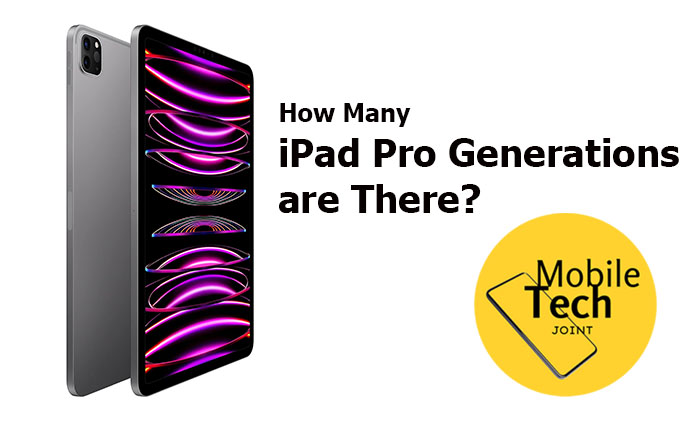The iPad Pro is a game-changer in the tablet market, setting a high standard for performance, design, and functionality. From creative professionals to everyday users, this device has found its way into many hands, offering a powerful alternative to traditional laptops.

But what really sets the iPad Pro apart? One key factor is its evolution across generations, each bringing new features and improvements that keep consumers coming back for more. Understanding these generations is crucial for anyone looking to invest in an iPad Pro
How Many iPad Pro Generations Are There?
The iPad Pro has come a long way since its introduction in 2015, evolving through five generations to become one of the most powerful and versatile tablets on the market. Whether you’re a creative professional, a student, or someone who needs a portable yet powerful device, there’s likely an iPad Pro that fits your needs.
The First Generation iPad Pro
Apple launched the first-generation iPad Pro in November 2015, marking a significant leap forward in the tablet world. It introduced a larger screen size, up to 12.9 inches, and the A9X chip, which offered impressive speed and graphics performance.
The inclusion of the Apple Pencil and Smart Keyboard also signaled Apple’s intent to position the iPad Pro as a serious tool for productivity and creativity. These innovations laid the groundwork for what would become one of Apple’s most successful product lines.
The Second Generation iPad Pro
Released in June 2017, the second-generation iPad Pro built on the foundation of its predecessor with several key enhancements. Apple introduced a 10.5-inch model, offering a new size option that balanced portability with screen real estate.
The ProMotion technology with a 120Hz refresh rate was another standout feature, providing smoother scrolling and more responsive Apple Pencil input. With an upgraded A10X Fusion chip, this generation offered even better performance, making it a favorite among power users.
The Third Generation iPad Pro
The third generation, launched in October 2018, brought one of the most significant design overhauls in the iPad Pro’s history. Apple reduced the bezels, allowing for larger screens in both the 11-inch and 12.9-inch models without increasing the overall device size.
The introduction of Face ID and the removal of the Home button gave the iPad Pro a modern, sleek look. Powered by the A12X Bionic chip, this generation also delivered desktop-class performance, making it a formidable competitor in the computing world.
The Fourth Generation iPad Pro
March 2020 saw the release of the fourth-generation iPad Pro, which continued to refine and enhance the user experience. One of the most notable upgrades was the new LiDAR scanner, which significantly improved augmented reality (AR) capabilities.
The dual-camera system, including an ultra-wide lens, brought more versatility to photography and video. This generation also introduced the Magic Keyboard with a built-in trackpad, transforming the iPad Pro into an even more capable laptop alternative.
The Fifth Generation iPad Pro
In April 2021, Apple launched the fifth-generation iPad Pro, which took performance to the next level with the introduction of the M1 chip, the same processor used in Apple’s latest Macs. This upgrade delivered a massive boost in speed, efficiency, and power management.
The 12.9-inch model also debuted a new mini-LED display, branded as the Liquid Retina XDR, offering stunning brightness and contrast levels. With 5G connectivity and Thunderbolt support, this generation set a new benchmark for what a tablet could do.
Comparison of Generations
When comparing the iPad Pro generations side by side, it’s clear that each iteration has brought meaningful improvements. From the introduction of larger screen sizes and ProMotion technology in the second generation to the M1 chip and mini-LED display in the fifth, Apple has consistently pushed the envelope.
Whether it’s processing power, display quality, or accessories like the Apple Pencil and Magic Keyboard, each generation has evolved to meet the growing demands of users.
Choosing the Right iPad Pro
So, which iPad Pro should you choose? It depends on your needs. If you’re on a budget, older generations like the third or fourth might offer the best value. For those needing cutting-edge performance, the fifth generation with the M1 chip is hard to beat.
Consider what you’ll be using the iPad Pro for—whether it’s creative work, gaming, or general productivity—and choose a model that aligns with your requirements and budget.
Future of the iPad Pro
Looking ahead, the future of the iPad Pro is filled with exciting possibilities. Rumors suggest that future generations could feature OLED displays, more advanced processors, and even deeper integration with macOS. As technology continues to evolve, so too will the iPad Pro, likely incorporating trends like artificial intelligence, enhanced AR capabilities, and more seamless connectivity.
Conclusion
The iPad Pro has come a long way since its first generation, evolving into a versatile, powerful tool that meets the needs of a wide range of users. Understanding the differences between each generation is key to making an informed purchase decision. As Apple continues to innovate, the iPad Pro remains at the forefront of tablet technology, offering a glimpse into the future of portable computing.
Also Check:
- How to Take Screenshot on iPad Pro
- iPad Pro not Charging when plugged in, how to fix
- My iPad Pro Won’t Turn On: Here’s How to Troubleshoot and Fix the Issue
- JOYWISE U18C Bluetooth Headphones: $19.99 Waterproof Sports Earbuds with 16 Hours Playtime
- ISOtunes Xtra 2.0 Earplug Earbuds: OSHA Compliant Bluetooth Hearing Protection for $79.99
